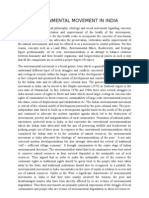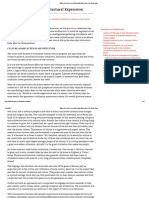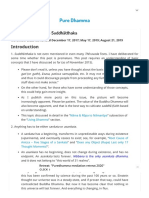Chipko MOvement
Chipko MOvement
Uploaded by
Rakhee LovesCopyright:
Available Formats
Chipko MOvement
Chipko MOvement
Uploaded by
Rakhee LovesCopyright
Available Formats
Share this document
Did you find this document useful?
Is this content inappropriate?
Copyright:
Available Formats
Chipko MOvement
Chipko MOvement
Uploaded by
Rakhee LovesCopyright:
Available Formats
The forests of India are a critical resource for the subsistence of rural peoples throughout the
country, but especially in hill and mountain areas, both because of their direct provision of food,
fuel and fodder and because of their role in stabilising soil and water resources. As these forests
have been increasingly felled for commerce and industry, Indian villagers have sought to protect
their livelihoods through the Gandhian method of satyagraha non-violent resistence. In the 1970s
and 1980s this resistance to the destruction of forests spread throughout India and became
organised and known as the Chipko Movement.
The first Chipko action took place spontaneously in April 1973 and over the next five years
spread to many districts of the Himalaya in Uttar Pradesh. The name of the movement comes
from a word meaning 'embrace': the villagers hug the trees, saving them by interposing their
bodies between them and the contractors' axes. The Chipko protests in Uttar Pradesh achieved a
major victory in 1980 with a 15-year ban on green felling in the Himalayan forests of that state
by order of India's then Prime Minister, Indira Gandhi. Since then the movement has spread to
Himachal Pradesh in the North, Kamataka in the South, Rajasthan in the West, Bihar in the East
and to the Vindhyas in Central India. In addition to the 15-year ban in Uttar Pradesh, the
movement has stopped clear felling in the Western Ghats and the Vindhyas and generated
pressure for a natural resource policy which is more sensitive to people's needs and ecological
requirements.
The Chipko Movement is the result of hundreds of decentralised and locally autonomous
initiatives. Its leaders and activists are primarily village women, acting to save their means of
subsistence and their communities. Men are involved too, however, and some of these have
given wider leadership to the movement. Prominent Chipko figures include: Sunderlal
Bahuguna, a Gandhian activist and philosopher, whose appeal to Mrs. Gandhi results in the
green-felling ban and whose 5,000 kilometre trans-Himalaya footmarch in 1981-83 was crucial
in spreading the Chipko message. Bahuguna coined the Chipko slogan: 'ecology is permanent
economy'.
Chandi Prasad Bhatt, one of the earliest Chipko activists, who fostered locally-based industries
based on the conservation and sustainable use of forest wealth for local benefit.
Dhoom Singh Negi, who, with Bachni Devi and many village women, first saved trees by
hugging them in the 'Chipko embrace'. They coined the slogan: 'What do the forests bear? soil,
water and pure air'.
Ghanasyam Raturi, the Chipko poet, whose songs echo throughout the Himalaya of Uttar
Pradesh.
Indu Tikekar, a doctor of philosophy, whose spiritual discourses throughout India on the ancient
Sanskrit scriptures and on comparative religion have stressed the unity and oneness of life and
put the Chipko Movement in this context.
You might also like
- Swami Vivekananda in The West: New Discoveries-3Document582 pagesSwami Vivekananda in The West: New Discoveries-3Mukunda HandeNo ratings yet
- ChipkoDocument4 pagesChipkoJulie ForemanNo ratings yet
- Name of The School: Project DetailsDocument5 pagesName of The School: Project DetailsAbhinand PrakashNo ratings yet
- Environment Case StudiesDocument10 pagesEnvironment Case StudiesYuvraj AggarwalNo ratings yet
- The Chipko Movement or Chipko AndolanDocument8 pagesThe Chipko Movement or Chipko AndolanKingkhan LuvsyouNo ratings yet
- Chipko MovementDocument10 pagesChipko MovementPrachiti GhogaleNo ratings yet
- Environmental MovementsDocument46 pagesEnvironmental MovementsAkshat Bhadoriya100% (1)
- Chipo Movement AssignDocument4 pagesChipo Movement AssignhovoboNo ratings yet
- Environmental Movement in IndiaDocument7 pagesEnvironmental Movement in IndiaAnupam Bhengra75% (4)
- The Chipko Movement FinalDocument7 pagesThe Chipko Movement Finaltitiksha Kumar100% (1)
- Chipko Movement: What Was It All About: Mr. Bahuguna Enlightened The Villagers by Conveying TheDocument10 pagesChipko Movement: What Was It All About: Mr. Bahuguna Enlightened The Villagers by Conveying TheAkshay Harekar50% (2)
- EVS AssignmentDocument3 pagesEVS AssignmentshiveshNo ratings yet
- Chipko MovementDocument17 pagesChipko Movementsmart prabhu100% (1)
- Geography Extra QuestionsDocument3 pagesGeography Extra Questionsvedaharshitha1No ratings yet
- Module 11Document15 pagesModule 11coolmanbalu2004No ratings yet
- Chipko MovementDocument6 pagesChipko MovementcpsahNo ratings yet
- Chipko Movement in IndiaDocument3 pagesChipko Movement in IndiaAnil EnvisNo ratings yet
- Environmental MovementsDocument3 pagesEnvironmental MovementsAMIT KUMARNo ratings yet
- Human RightsDocument34 pagesHuman RightsAkshaya ReddyNo ratings yet
- Chipko MovemntDocument6 pagesChipko MovemntAshwin sureshNo ratings yet
- ChipkoDocument2 pagesChipkoAasthaNo ratings yet
- Chipko MovementDocument22 pagesChipko Movementmirmax124100% (2)
- Chipko Movement - Samprit Saha PDFDocument12 pagesChipko Movement - Samprit Saha PDFSampriti SahaNo ratings yet
- Chipko Movement A Landmark-2059Document4 pagesChipko Movement A Landmark-2059Akash AgrawalNo ratings yet
- Chipko MovementDocument16 pagesChipko MovementKC G Madhu100% (1)
- Unit 7 Human Communities & The EnvironmentDocument11 pagesUnit 7 Human Communities & The EnvironmentAporupa BarNo ratings yet
- 15876176100EVSAECC01 Environmental MovementsDocument4 pages15876176100EVSAECC01 Environmental MovementsNancy NancyNo ratings yet
- Community and ConservationDocument11 pagesCommunity and ConservationMukesh KumarNo ratings yet
- ChipkoDocument3 pagesChipkoVepashyana VaidNo ratings yet
- Chipko MovementDocument11 pagesChipko MovementMadhan sharma100% (1)
- Enviroenmetal Movement 4Document7 pagesEnviroenmetal Movement 4h8944230No ratings yet
- Environmental Movements in IndiaDocument8 pagesEnvironmental Movements in IndiaNikil Abraham RonNo ratings yet
- Chipko MovementDocument2 pagesChipko Movementdeepaagr1919No ratings yet
- Seema Mams Favourite StudentsDocument16 pagesSeema Mams Favourite Studentsnayakantiramasubbaiah0No ratings yet
- Evs presentationnDocument16 pagesEvs presentationnGeetuNo ratings yet
- Chipko MovementDocument3 pagesChipko MovementPrem KavathiyaNo ratings yet
- Env. MOvementDocument3 pagesEnv. MOvementbokul1No ratings yet
- Chipko Movement FinalDocument11 pagesChipko Movement FinalSulochana NalawadeNo ratings yet
- Chipko MovementDocument4 pagesChipko MovementPooja ChaudhariNo ratings yet
- Chipko Movement PDFDocument15 pagesChipko Movement PDFTanaya BorseNo ratings yet
- Re-Evaluating The Chipko (Forest Protection) Movement in India Byshinya IshizakaDocument19 pagesRe-Evaluating The Chipko (Forest Protection) Movement in India Byshinya Ishizaka5705robin0% (1)
- Chipko MovementDocument9 pagesChipko MovementAviral Srivastava67% (3)
- EVS ProjectDocument5 pagesEVS ProjectChayananda Muniswama TNo ratings yet
- Chipkomovement 130909034658Document14 pagesChipkomovement 130909034658Febin Kurian FrancisNo ratings yet
- Chipko MovementDocument15 pagesChipko MovementPranshu SinhaNo ratings yet
- Evs Assignment KanishkaDocument7 pagesEvs Assignment Kanishkakanishkkaa21No ratings yet
- 7 Major Environmental Movements in IndiaDocument9 pages7 Major Environmental Movements in IndiaKhusbu KumariNo ratings yet
- Environmental Movements in IndiaDocument1 pageEnvironmental Movements in IndiaRahul RajwaniNo ratings yet
- Group 8 Environmental Movements in IndiaDocument24 pagesGroup 8 Environmental Movements in IndiaV ANo ratings yet
- 542799581 Group 8 Environmental Movements in India 1Document24 pages542799581 Group 8 Environmental Movements in India 1Sarikonda SaikiranNo ratings yet
- Chipko Movement:-: UNIT-5Document7 pagesChipko Movement:-: UNIT-5aayuxh14No ratings yet
- ENVIRONMENTAL MOVEMENTS IN INDIA FC ProjectDocument10 pagesENVIRONMENTAL MOVEMENTS IN INDIA FC Projectgayatri panjwaniNo ratings yet
- Environmental MovementsDocument6 pagesEnvironmental MovementsShailjaNo ratings yet
- Chipko MovementDocument2 pagesChipko Movementimran.khandnsNo ratings yet
- Get Complete Information On Various Movements in IndiaDocument2 pagesGet Complete Information On Various Movements in Indiaforquizlet777No ratings yet
- Chipko Movement - Wikipedia'sDocument27 pagesChipko Movement - Wikipedia'skarthik bharadwajNo ratings yet
- Chipko MovementDocument10 pagesChipko Movementkunalkumar264No ratings yet
- Environmental Movements (Aecc-2, Unit 7) Bishnoi MovementDocument6 pagesEnvironmental Movements (Aecc-2, Unit 7) Bishnoi MovementSPN CDYNo ratings yet
- Chipko MovementDocument15 pagesChipko MovementKaushik InamdarNo ratings yet
- Record# RANK All India Rank in Income Tax RollDocument33 pagesRecord# RANK All India Rank in Income Tax RollMadhab MondalNo ratings yet
- Partition in NovelsDocument18 pagesPartition in NovelsemasumiyatNo ratings yet
- Holiday CalendarDocument1 pageHoliday CalendarviyogakalNo ratings yet
- Hinduastronomy00brenuoft PDFDocument364 pagesHinduastronomy00brenuoft PDFAlok Sharma100% (1)
- United Bank of India - Recruitment of Clerks Online Application Form For The Post of ClerksDocument3 pagesUnited Bank of India - Recruitment of Clerks Online Application Form For The Post of Clerksvineet883No ratings yet
- Buddhacarita, Acts of Buddha - E.H - JonhstonDocument121 pagesBuddhacarita, Acts of Buddha - E.H - JonhstonhaluulyNo ratings yet
- Book Review - The Immortals of MeluhaDocument3 pagesBook Review - The Immortals of MeluhaSwati PandaNo ratings yet
- AlertNo1 (2017) ConfirmedListDocument358 pagesAlertNo1 (2017) ConfirmedListHimanku BoraNo ratings yet
- 2 Explanation of Navkar Maha Mantra (Pratikramana Sutra)Document69 pages2 Explanation of Navkar Maha Mantra (Pratikramana Sutra)jinavachan100% (1)
- Devadasi System in India and Its Legal Initiatives - An AnalysisDocument6 pagesDevadasi System in India and Its Legal Initiatives - An AnalysisInternational Organization of Scientific Research (IOSR)No ratings yet
- Yoga Report 2017Document310 pagesYoga Report 2017upsc.bengalNo ratings yet
- Effect of Culture on Architectural Expression - Aζ South AsiaDocument9 pagesEffect of Culture on Architectural Expression - Aζ South AsiabhagyasriNo ratings yet
- EMS ResultDocument1 pageEMS ResultShruti SawaleNo ratings yet
- Week 8 - HINDUISM - Assessment Questions - StudentDocument15 pagesWeek 8 - HINDUISM - Assessment Questions - Studentnm89bzv7pvNo ratings yet
- Origin of Matter - Suddhātthaka Created by The MindDocument7 pagesOrigin of Matter - Suddhātthaka Created by The MindMahesh NahallageNo ratings yet
- B Haja Govinda MDocument30 pagesB Haja Govinda MVenu KumarNo ratings yet
- Illiteracy and Disparity in EducationDocument3 pagesIlliteracy and Disparity in EducationAditya Kumar100% (1)
- TheArtofPoetry 10108257 PDFDocument366 pagesTheArtofPoetry 10108257 PDFAamna humayunNo ratings yet
- Effective Yoga Asanas To Manage High Blood PressureDocument13 pagesEffective Yoga Asanas To Manage High Blood PressuresharmilaNo ratings yet
- Preliminary List of Damaged Monuments - 30 July 2015 - DistrictsDocument12 pagesPreliminary List of Damaged Monuments - 30 July 2015 - DistrictsarchifirmNo ratings yet
- Samadhi-Gheranda SamhitaDocument2 pagesSamadhi-Gheranda SamhitaPathik Nira YogaNo ratings yet
- Eternal Bliss-The Essence of Siva-GnanamDocument7 pagesEternal Bliss-The Essence of Siva-GnanamSivasonNo ratings yet
- Staff List - PDocument92 pagesStaff List - PChahat ManglaNo ratings yet
- HandBook of Abhidhamma Studies Vol 2 - Ven Dr. SilanandaDocument422 pagesHandBook of Abhidhamma Studies Vol 2 - Ven Dr. SilanandaBuddhaDhammaSangahNo ratings yet
- Telephone DiaryDocument8 pagesTelephone DiaryRakshit KumarNo ratings yet
- DC Chennai 03.02.2020 PDFDocument15 pagesDC Chennai 03.02.2020 PDFTyson KicksNo ratings yet
- DHS-contacts 27012015839Document7 pagesDHS-contacts 27012015839AbdulRahmanNo ratings yet
- FormatDocument5 pagesFormatPrudhvi RajNo ratings yet
- Temple Entry Movement in Travancore - Robbin JeffryDocument25 pagesTemple Entry Movement in Travancore - Robbin JeffrySiddalingappa SidramaNo ratings yet

























































































